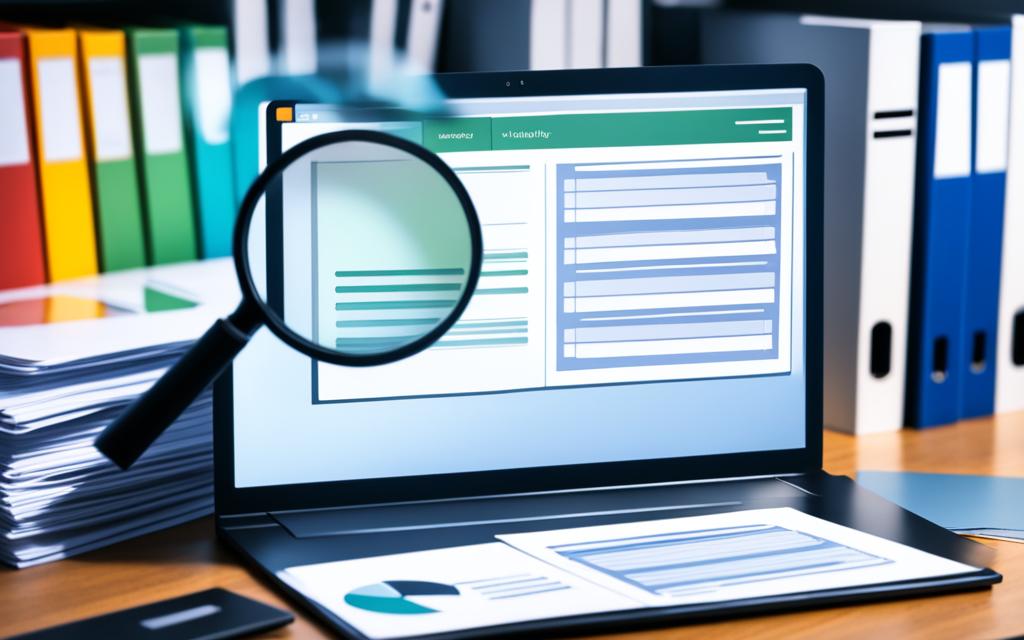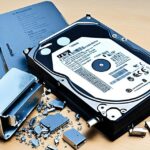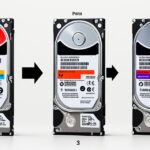Table of Contents
Learning how to check your computer’s storage is key for keeping it running well. Keeping an eye on hard drive space helps spot storage problems early. It also ensures your computer works smoothly and keeps file clutter low. With more space available now than ever, it’s vital to regularly check what is taking up space1. This guide will help you learn the steps for different systems. You’ll get the know-how to keep your storage in top shape.
This guide covers how to see what’s using your space on both Windows and Mac. You’ll also discover how tools like EaseUS Partition Master make this easy and quick2. Whether you’re just starting or have been around computers for years, these tips will help you manage your storage better.
Key Takeaways
- Regularly monitor your computer storage to avoid performance issues.
- Using built-in tools can provide quick insights into storage usage.
- Third-party software can enhance ease and efficiency in checking storage.
- Different operating systems have varied methods for managing storage.
- Clean up space regularly to optimise your system’s performance.
Understanding Computer Storage
Exploring computer storage types sheds light on data management across different gadgets. At their heart are Hard Disk Drives (HDD) and Solid State Drives (SSD). Each has unique benefits and performance levels. HDDs offer more space for those needing lots of storage. SSDs, on the other hand, excel in speed and reliability, perfect for tasks requiring quick access.
Storage comes in different sizes, measured in gigabytes (GB) and terabytes (TB). Knowing about hard drive capacity means understanding two measurement standards: decimal and binary. For example, 1 kilobyte (KB) is 1,000 bytes in decimal form, but 1,024 bytes in binary. With data amount expected to reach 163 zettabytes (ZB) by 2025, it’s crucial to get these terms right3.
Each storage medium offers something different. HDDs are great for holding many files, while SSDs boost speed and improve how we use our devices. As storage units evolve, companies use tiered storage systems. They help balance the need for quick access with keeping data safe3.
- HDDs: Affordable, with large storage but slower to use.
- SSDs: Provide quick access and are reliable but cost more per GB.
When thinking about hard drive space, it’s key to look beyond just the amount. Considering the speed at which you can access your files is important too. With many Windows PCs using HDDs, understanding their storage and speed helps in making better storage choices4.
| Storage Type | Capacity Range | Speed | Price (Approx.) |
|---|---|---|---|
| HQ | 500 GB to 12 TB | Slow | $50 – $300 |
| SSD | 120 GB to 8 TB | Fast | $60 – $600 |
The Importance of Monitoring Your Storage
It’s crucial to keep an eye on your storage to maintain its best performance and avoid problems. Monitoring helps to prevent slowdowns caused by not having enough space. Knowing how much storage you are using can stop bad things like file corruption and software crashes.
Good storage management means knowing the risks of having too much stored data. Setting up automatic alerts helps find problems early. For example, alerts warn you when you’re using too much disk space. This early warning helps avoid bigger problems later5. It’s essential to set these limits. They keep everything running smoothly, especially in complex digital systems6.
When managing storage, you should look at disk use, how many tasks it’s doing, and when it’s not busy. Understanding these things helps you use your resources better. This improves how well your system works. If you wait too long to monitor your storage, you could face big problems. This makes monitoring a key part of keeping your system healthy.
| Aspect | Description |
|---|---|
| Disk Usage | The amount of storage currently in use. |
| Threshold Alerts | Warnings issued when usage exceeds 80% (warning) and 90% (critical). |
| Performance Metrics | Key indicators to assess storage health, including I/O operations and queue lengths. |
| Automation | Solutions to automatically handle performance issues and ensure efficient server health. |
| Future Monitoring Capabilities | Upcoming updates may allow monitoring of individual directories. |
How to Check Computer Storage on Windows
It’s crucial to know how to check storage on Windows to keep your computer running smoothly. Windows gives you several ways to watch how much space you’re using, so you can make sure there’s enough. You can look at storage through the Settings, use File Explorer, or try out software made by others for deeper details.
Using Windows Homes
Getting storage details from Windows Settings is simple. First, hit the Start button, then click the gear-shaped icon for Settings. Go to System and hit Storage. This shows you how your hard drive’s space is used by different types of files. It lets you see and adjust how your storage is managed, with options to dive deeper if you want.
Checking via File Explorer
For a fast check, open File Explorer and click on This PC in the side menu. You’ll see all your drives and how much space they have left under each one. This method is straightforward and helps you quickly see used and available space4.
Employing Third-Party Software
For more detailed analysis, try third-party software like EaseUS Partition Master. It breaks down how files of different sizes take up space, making it easier to spot the big ones. Third-party tools offer visual aids and extra options like managing disks. They can give you a closer look, adding to what you get from Windows itself7.
How to Check Computer Storage on a Mac
Knowing how to check your Mac’s storage is key as our digital needs grow. All it takes is a few steps in the Apple menu to see how you’re using your space. Here’s how you can do it easily.
First, find the Apple logo at the top left of your screen and click it. Then choose “About This Mac” from the dropdown. You’ll see an overview of your system, including storage details.
For more info, click the “Storage” tab. A bar graph will show you how your storage is used. It splits it into categories like apps, documents, and media files8.
To manage your storage better, press “Manage”. This reveals what kinds of files are taking up space8.
Accessing the Storage Tab
The “Storage” tab not only reveals used space but also available space in megabytes or gigabytes. This clear view helps you understand your Mac’s storage capacity9. Checking it regularly lets you know when to tidy up files.
Using services like iCloud can free up space by storing large files off your Mac10.
How to Check Computer Storage on Mobile Devices
Learning to manage your mobile storage is key for keeping your device running smoothly. It’s helpful to understand how to check storage on both iPhones and Androids. This knowledge can make your device last longer and work better.
Checking Storage on iPhones
To find out how much storage you have on an iPhone, just follow these easy steps:
- Open the Settings app.
- Tap on General.
- Select iPhone Storage to see how much space apps, photos, media, and messages use11.
In this area, you might get tips on how to free up space. Remember, some files like cached data aren’t removed automatically and can use a lot of room. Keep an eye on these to better manage your storage11.
Reviewing Storage on Android Devices
If you have an Android, checking storage is straightforward:
- Open the Settings app.
- Go to Device.
- Tap on Storage & USB to see the space you’re using and what’s free.
Should you find certain apps using too much space, you might decide to remove them. Your phone can also auto-archive apps you’re not using much, which helps free up space while keeping your data safe12. Look in the Play Store settings to turn this feature on12.
Another tip to save space is moving files to a computer with a USB cable. This way, you free up phone space and keep your files secure12.
Cleaning Up Your Storage Space
Keeping your computer’s storage clean is key for it to work well. Removing files you don’t need stops your system from getting slow. This lets programs run better and saves a lot of space.
Using the Disk Cleanup tool is smart. It finds and gets rid of files you don’t need. Also, on Windows 10 or 11, go to Settings > System > Storage to see how much space you have. It helps you decide what to toss out13.
Getting rid of apps you don’t use also helps a lot. You can find them in Settings > Apps. On both macOS and mobile, doing this frees up space.
It’s also important to keep your files in order. Look through your Downloads and Pictures folders. You might find stuff you can delete. Don’t forget to check your recycle bin. You can set your computer to automatically clear out trash after so long13.
Think about using Google Drive, OneDrive, or Dropbox for cloud storage. These services let you keep files off your computer. Trend Micro and similar software can help keep your disk space tidy14.
| Task | Operating System Instructions |
|---|---|
| Disk Cleanup | Windows: Use Disk Cleanup tool |
| Uninstall Apps | Windows: Settings > Apps > Apps & features |
| Review Files | Navigate through Pictures and Downloads folders |
| Setup Automatic Storage Management | Windows: Configure Storage Sense settings |
| Utilise Cloud Storage | Archive files on Google Drive, OneDrive, or Dropbox |
Conclusion
It’s vital for everyone to know how to check computer storage, no matter the system they use. There are specific ways for checking storage on Windows, Mac, and mobile devices. It helps keep the system healthy.
This guide shows different methods, like Windows’ tools or Mac’s interfaces, for monitoring storage. Regular disk checks help remove files you don’t need. This keeps your device running well.
Making storage checks a part of your routine is key for managing your digital life well. With the insights from this guide, you can better handle your device. It boosts your confidence in dealing with digital technologies.
Sticking to these practices greatly improves how your computer works. It makes you more productive in everything you do. This is true for both your personal and work life151617.
FAQ
How can I check my computer’s storage on Windows?
To check your computer’s storage on Windows, go to the Start menu. Then choose “Settings,” followed by “System,” and click on “Storage.” This shows how your storage space is used.
What are the differences between HDD and SSD?
HDDs, or Hard Disk Drives, use spinning disks to store data. SSDs, or Solid State Drives, are faster and use flash memory without moving parts. SSDs perform better and are quicker than HDDs.
Why is it important to monitor my storage space?
Checking your storage space often is key to avoid your computer slowing down. It helps prevent data loss and keeps apps running well. If you don’t watch your storage, you might run into problems like file corruption or software crashes.
How do I check the storage on my Mac device?
On a Mac, click the Apple logo at the top left. Choose “About This Mac,” then go to “Storage.” You’ll see how storage is used, broken down by file type.
Q: What steps should I take to clean up my storage space?
To clean your storage, start by deleting files you don’t need, like temporary ones. Remove apps that you aren’t using. Use features like Windows Storage Sense or macOS storage management to help keep your system running smoothly.
How can I check the storage on my mobile device?
For iPhone storage, head to “Settings,” pick “General,” then “iPhone Storage” for a summary of your usage. Android users, go to “Settings,” find “Device,” and tap “Storage & USB” for space details.
What should I do if my storage is nearly full?
If you’re running out of space, look for files or apps you don’t need and delete them. Make use of system tools to manage storage. Also, think about getting an external drive or a larger internal drive to increase storage.
Source Links
- https://www.wikihow.com/Check-Your-Hard-Disk-Space – How to Check Your Hard Disk Space: PC, Mac, & Smart Phones
- https://www.easeus.com/partition-master/how-to-check-storage-on-pc.html – How To Check Storage on PC [Step-by-Step Guide]
- https://www.techtarget.com/searchstorage/definition/storage – What is computer storage and how is it used?
- https://www.businessinsider.com/guides/tech/how-to-check-windows-storage – How to check your Windows computer’s storage space in 2 ways, and see how your data is being stored
- https://www.netdata.cloud/blog/disk-usage/ – How to monitor the disk usage on your infrastructure | Netdata
- https://infraon.io/blog/what-is-disk-io/ – Disk I/O: Importance & Best Features of Monitoring | 2024 | Infraon
- https://superuser.com/questions/749770/windows-how-can-i-see-disk-space-used-over-time – Windows: How can I see disk space used over time?
- https://www.businessinsider.com/guides/tech/how-to-check-mac-storage – How to check your Mac computer’s storage space in 2 different ways
- https://mackeeper.com/blog/how-to-check-storage-on-mac/ – How to Check Storage on Mac
- https://setapp.com/how-to/check-disk-space-on-your-mac – Check the available hard drive space on a Mac
- https://support.apple.com/en-us/108429 – How to check the storage on your iPhone and iPad – Apple Support
- https://support.google.com/android/answer/7431795?hl=en – Free up space – Android Help
- https://www.pcmag.com/how-to/free-up-hard-disk-space-on-windows-10 – How to Free Up Disk Space in Windows
- https://helpcenter.trendmicro.com/en-us/article/tmka-20815 – How to Free Up Disk Space on Windows
- https://www.easeus.com/partition-manager-software/check-disk-usage.html – How to Check/View Disk Storage/Usage on Windows 10/11
- https://diggitymarketing.com/web-hosting/what-is-disk-space/ – What Is Disk Space?
- https://www.easeus.com/partition-manager-software/check-total-disk-space-windows-11.html – How to Check Total Disk Space in Windows 11 [Best Solutions Here]








